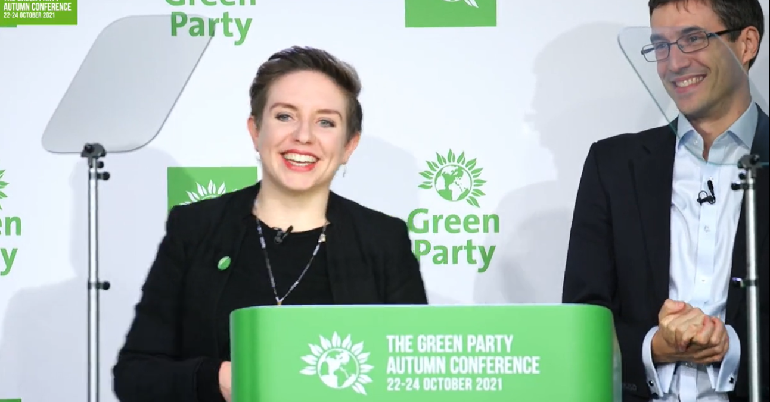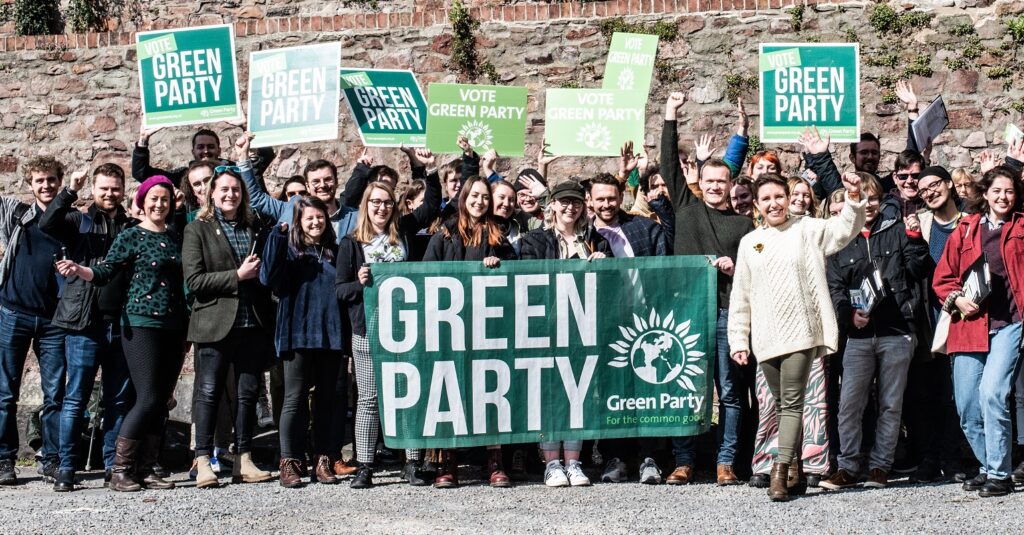5 things to look out for at Green Party conference

Members of the Green Party of England and Wales will be meeting in Birmingham from 11-12 March for the party’s spring conference. The biannual event will see keynote addresses from the party’s leadership, as well as members thrashing out elements of the Greens’ policy platform.
Although it’s a day shorter than usual, this year’s agenda is still packed, and there are a raft of interesting developments that may come off the back of it. In light of this, we’re running down the 5 big things to look out for at this year’s Green Party conference.
1. The HS2 debate
Few discussions within the Green Party get as heated as that surrounding HS2. Campaign group Greens4HS2 was set up in 2021 in an effort to shift the party’s position on the controversial rail project. Since, they’ve attracted supporters and detractors galore.
Members of Greens4HS2 have brought a motion to the Greens’ spring conference which would see the party’s position switch from opposition to support. The motion asks members to endorse a position of backing government funding for HS2, building the rail line including the leg to Leeds, and delivering the ‘Northern Powerhouse’ high speed rail project.
Greens4HS2 have been campaigning hard to persuade members of their position. Recent interviews and articles from their team have unsurprisingly sparked intense discussion. They have also sparked a counter-campaign from opponents of HS2. Over 200 Green Party members have signed an open letter opposing the motion. The letter has a number of high profile signatories including one of the Greens’ two members of the House of Lords – Jenny Jones. In their letter, the HS2 opponents say that shifting the party’s stance on HS2 would be an “utter betrayal” of campaigners who fought against the project.
With participants in the debate from all sides becoming increasingly hostile, tensions will be high if the motion is discussed on conference floor. However, given its position in the agenda, it is possible that it won’t make the cut. Members have prioritised other motions, and the party’s conference is not known for speeding through business. That means it’s possible this particular row will rumble on to the autumn.
2. Where the party stands on NATO
Why have one major policy debate when you can have two? Also on the agenda for the weekend is the Greens’ attitude to NATO.
Bundled into a proposed rewrite of the party’s overarching policies on peace, security and defence, the proposals would see the Greens ditch their opposition to NATO. Presently, the party’s policy states that NATO is “not a sustainable mechanism for maintaining peace in the world”, and says that the Green Party “would take the UK out of NATO”.
If passed, the new policy would abandon that commitment. While a previous iteration of the proposal was more extreme in its wording (describing NATO as a ‘guarantor of freedom’), the text now going before conference seeks to push the party to adopt a ‘remain and reform’ stance on the military alliance.
If passed, the Green Party’s policy would state that “NATO has an important role in ensuring the ability of its member states to respond to threats to their security”. It would go on to call for NATO to guarantee a no first use policy on nuclear weapons, commit to upholding human rights in NATO’s actions and to act “solely in defence of member states”.
This would be a dramatic shift in the Greens’ policy on international issues. There is a not-insubstantial portion of the party’s membership that have clearly moved since Russia’s invasion of Ukraine. However, the anti-imperialist and peace-oriented current remains strong within Green politics. Last year, the Scottish Greens rewrote their defence policies in light of the invasion of the Ukraine. But, as Ross Greer explained at the time, the party retained its commitment to leaving NATO.
It remains to be seen where the balance of opinion lies within the Green Party of England and Wales. We will find out when conference votes.
3. How the Greens elect their leaders
The Green Party’s current leadership structure is a bizarre fudge. It emerged following the 2012 leadership and deputy leadership election when Natalie Bennett emerged victorious in the poll for the top job. At the time, the party’s rules required that if the leader of the party was a woman, the deputy leader had to be a man (and vice versa). That meant that the two women who stood for the deputy leadership (Alex Phillips and Caroline Allen) were automatically excluded from the contest.
The absurdity of the situation was that rules intended to improve the representation of women in politics had the opposite effect. As a result of the rules’ phrasing, the Greens were the only party in the country that prohibited two women from occupying leadership positions. Seeking to address this absurdity, a series of proposals were put forward, with a fudged compromise winning the day.
That compromise has been in place ever since and it means that the party elects a leader and two deputy leaders, with the latter having to be different genders to each other. That’s the case unless a pair of co-leaders are elected. Then, the two co-leaders have to be of different genders and the party elects just one deputy. An improvement on the old system in that it ensured the party did not reserve leadership positions for men, and recognised the multitude of genders that exist, it is nevertheless unwieldy and only goes someway at addressing issues of representation. It has often been pointed out that what these rules still prevent is two women standing jointly on a co-leadership ticket or two women deputy leaders being elected.
There are two motions to this coming conference which seek to remedy this and address wider issues of representation.
The first would seek to scrap the prohibition on women job-sharing the party leadership. It would rewrite the rules so that the same mechanism for electing a single leader and two deputies or two co-leaders and one deputy apply. But it would alter the gender balancing rules so that it would only prevent two men from sharing the same post, but two women – or indeed two non-binary people – would be able to.
The second would introduce a mechanism designed to reduce the likelihood of elections to the leadership (and other elected positions within the party, such as those on the Executive) from comprising solely candidates who are white men. It would introduce a second round of nominations if the first round only sees white men put their name forward.
Neither of these have ended up particularly high on the agenda, but it is reasonably likely that the latter will be debated. Were either to pass, it would be the first major shakeup of the process for leadership elections in a decade.
4. Future of party governance
Less high profile, but nevertheless still deeply anachronistic is the Green Party’s processes for its governing bodies. Presently, the party has two such bodies.
The Green Party Executive (GPEx) has half of its members elected each year. Members are elected to specific portfolios – such as treasurer, elections coordinator and international coordinator – and the body is responsible for overseeing the party’s day to day management and finances. The portfolios on GPEx were created at a time when the party had little in the way of a professional staff team, and core party functions were carried out by volunteers.
The Green Party Regional Council (GPRC) has two representatives from each region. GPRC is responsible for advising GPEx on the party’s political strategy, is empowered to issue policy statements between conferences and undertakes work related to party discipline. The unevenly sized regions are a shibboleth from Britain’s membership of the EU, being defined as they are by the old European Parliamentary constituencies.
This setup was established decades ago, with its roots in changes made to the party’s constitution in 1991. There has long been a broad consensus within the party that these structures are no longer fit for purpose. However, various attempts to reform it (including the long-running ‘holistic review’) have been thwarted for a range of reasons, detailing which would take this article well beyond a reasonable word count.
At the forthcoming conference, attempts to reform these structures are once again on the agenda.
One motion seeks to shrink the size of GPEx, reducing its voting membership from 17 positions to 13. It would also abolish most of the specific portfolios for members of the Executive, with their work instead being overseen by working groups.
A second motion relates to GPRC, with proposed changes that are arguably more substantial than those suggested for GPEx. This motion would replace GPRC with a new body, named the Green Party Council, which would have a membership of 36 as opposed to GPRC’s current 20. 12 members of the Council would be elected every year via an annual ballot for three year terms. These would be elected by the membership of the whole party, rather than the membership within the regions.
On the face of it, this all sounds quite dry. In reality, it probably is. But it would nonetheless represent the biggest reordering of the Green Party’s governance in decades. If passed, these two motions would be the culmination of years of wrangling over the party’s internal organisation.
Even if you have no interest in the party’s governance processes, if you are a Green Party member you almost certainly have an interest in members spending less time arguing about the constitution. Unfortunately, neither of these motions have been prioritised particularly highly, so it’s likely that time will indeed be spent on these questions at future conferences too.
5. Insight into what the Greens see as their prospects at this year’s local elections
Outside of the policy debates and the lengthy discussions of the rule book, one of the core features of Green Party conference is typically the keynote speeches from the party’s leadership and elected figures. This year, the party has done away with this, with only two speeches timetabled into the programme. One, from former MEP Ellie Chowns and the other from the party’s co-leaders Carla Denyer and Adrian Ramsay.
Interestingly, the latter isn’t billed as a typical leader’s speech. Instead, it is on the agenda as a ‘local elections update from our co-leaders’. Eschewing the traditional rhetoric laden rally of the party faithful, this contribution will perhaps provide a more interesting insight into the current state of the party.
2023’s local elections are an important test for the Greens. The seats up for election were last contested in 2019, when the party more than doubled its representation in local government overnight. While many of the seats it won were down to years of hard graft and campaigning, there were some that were surprise victories. Retaining these seats and seeking to make new inroads is a tall order, given that the Greens will be defending more seats than it ever has before on a single night.
Still, prominent figures in the Greens have been bullish about prospects in this year’s contests. Carla Denyer has said the Green Party could gain 100 seats in May. Caroline Lucas has talked up the chances of the Greens taking control of Mid Suffolk Council. There are other Councils – particularly in more rural, traditionally Tory controlled areas – where the Greens could make big leaps forward in representation.
Bright Green will soon be releasing a detailed breakdown of the Greens’ prospects in the upcoming local elections. But for members wanting a taste of what lies ahead, this session at conference should deliver.
PS. We hope you enjoyed this article. Bright Green has got big plans for the future to publish many more articles like this. You can help make that happen. Please donate to Bright Green now donate to Bright Green now.




Leave a Reply